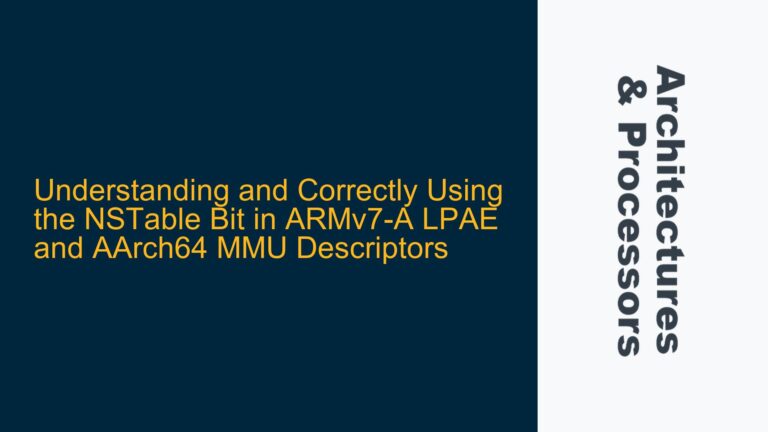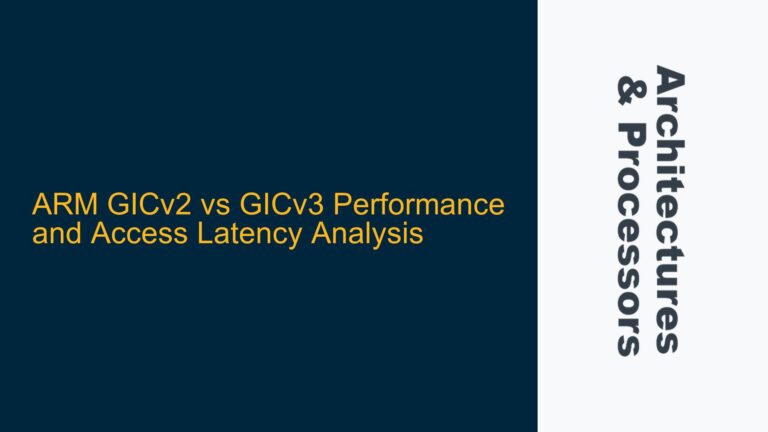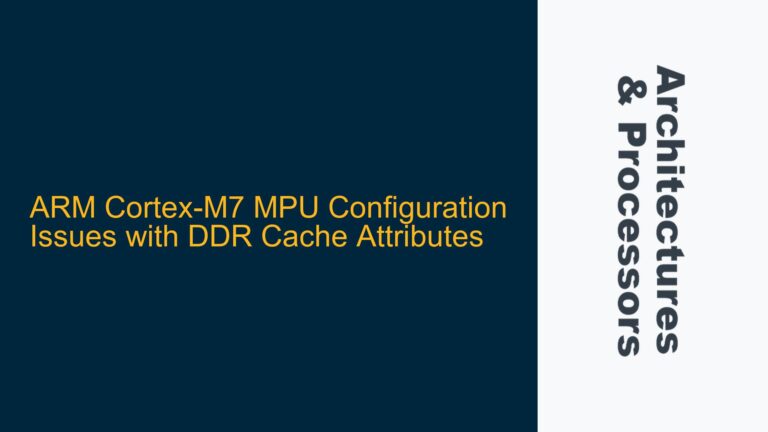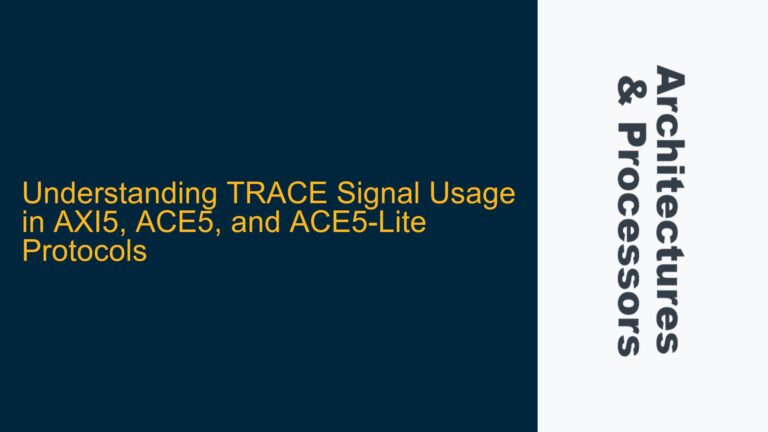AXI ID Width Mismatch in Dual-System ARM Cortex-A15 and Cortex-R7 Integration
When integrating two independent ARM-based systems, such as a Cortex-A15 and a Cortex-R7, each operating on separate AXI buses, a common challenge arises when attempting to interconnect these systems for mutual access. The primary issue stems from the AXI ID width configuration, which is inherently tied to the slave interface requirements and the number of connected masters. In this scenario, the Cortex-A15 and Cortex-R7 systems are designed with different AXI ID widths, leading to a conflict when forming an access loop between the two systems. The AXI protocol mandates that the ID width of a master must align with the ID width supported by the slave, and any mismatch can result in data corruption, transaction failures, or system deadlocks.
The Cortex-A15 typically operates with a wider AXI ID width to support multiple outstanding transactions and high-performance data processing, while the Cortex-R7, being a real-time processor, often uses a narrower AXI ID width optimized for deterministic behavior. When these systems are interconnected, the AXI fabric must handle transactions with varying ID widths, which is not natively supported by the AXI protocol. This mismatch can cause the AXI interconnect to misinterpret transaction IDs, leading to incorrect routing, data corruption, or even system crashes.
To further complicate matters, the AXI protocol does not provide a built-in mechanism for ID width adaptation between masters and slaves. This limitation necessitates a custom solution to ensure seamless communication between the two systems. The challenge lies in maintaining transaction integrity while accommodating the differing ID widths, ensuring that the system remains functional and efficient.
Root Causes of AXI ID Width Conflict in Multi-System Integration
The root cause of the AXI ID width conflict lies in the architectural differences between the Cortex-A15 and Cortex-R7 systems. The Cortex-A15, designed for high-performance applications, typically employs a wider AXI ID width to support multiple outstanding transactions and complex memory access patterns. This wider ID width allows the Cortex-A15 to issue numerous concurrent transactions, each uniquely identified by its ID, enabling efficient pipelining and out-of-order execution.
In contrast, the Cortex-R7, optimized for real-time and deterministic behavior, often uses a narrower AXI ID width. This narrower width reduces the complexity of the AXI fabric and minimizes latency, which is critical for real-time applications. However, when these two systems are interconnected, the disparity in ID widths creates a fundamental incompatibility. The AXI protocol relies on the ID field to track transactions, and any mismatch in ID width can lead to incorrect transaction routing, data corruption, or system deadlocks.
Another contributing factor is the lack of a standardized mechanism for ID width adaptation in the AXI protocol. While the protocol provides flexibility in configuring ID widths, it does not define a method for dynamically adapting IDs between masters and slaves with different width requirements. This limitation forces designers to implement custom solutions, which can introduce additional complexity and potential points of failure.
Furthermore, the AXI interconnect fabric must be carefully designed to handle the differing ID widths. The interconnect must ensure that transactions are correctly routed and that the ID fields are appropriately managed to prevent conflicts. This requires a deep understanding of the AXI protocol and the specific requirements of the connected masters and slaves.
Resolving AXI ID Width Conflict Through ID Remapping and Interconnect Design
To resolve the AXI ID width conflict in a multi-system integration scenario, a combination of ID remapping and custom interconnect design is required. The goal is to ensure that transactions between the Cortex-A15 and Cortex-R7 systems are correctly routed and that the ID fields are appropriately managed to prevent conflicts.
ID Remapping Strategy:
The first step in resolving the AXI ID width conflict is to implement an ID remapping mechanism. This mechanism translates the ID fields of transactions as they pass between the two systems, ensuring that the ID width requirements of both the master and slave are met. The remapping logic must be carefully designed to handle the differing ID widths and to ensure that transaction integrity is maintained.
For example, if the Cortex-A15 uses a 12-bit ID width and the Cortex-R7 uses an 8-bit ID width, the remapping logic must map the 12-bit IDs from the Cortex-A15 to 8-bit IDs for the Cortex-R7. This mapping can be achieved using a lookup table or a mathematical function that ensures unique IDs are maintained for each transaction. The remapping logic must also handle the reverse mapping when transactions are initiated by the Cortex-R7 and targeted at the Cortex-A15.
Custom Interconnect Design:
In addition to ID remapping, the AXI interconnect fabric must be designed to handle the differing ID widths. The interconnect must ensure that transactions are correctly routed between the two systems and that the ID fields are appropriately managed. This requires a deep understanding of the AXI protocol and the specific requirements of the connected masters and slaves.
The interconnect design must include logic to handle the ID remapping and to ensure that transactions are correctly routed. This logic must be carefully optimized to minimize latency and to ensure that the system remains efficient. The interconnect must also handle any potential conflicts that may arise due to the differing ID widths, such as ensuring that transactions are correctly ordered and that data integrity is maintained.
Verification and Testing:
Once the ID remapping and interconnect design are implemented, thorough verification and testing are required to ensure that the system functions correctly. This includes simulating various transaction scenarios to verify that the ID remapping logic works as intended and that the interconnect correctly routes transactions between the two systems.
Verification should also include stress testing to ensure that the system can handle high transaction volumes and that the ID remapping logic does not introduce any bottlenecks. Additionally, the system should be tested for corner cases, such as transactions with maximum ID values, to ensure that the ID remapping logic handles all possible scenarios.
Performance Optimization:
Finally, the system should be optimized for performance. This includes minimizing the latency introduced by the ID remapping logic and ensuring that the interconnect fabric is efficient. Performance optimization may involve tuning the remapping logic, optimizing the interconnect design, and ensuring that the system can handle the expected transaction load.
In conclusion, resolving the AXI ID width conflict in a multi-system integration scenario requires a combination of ID remapping, custom interconnect design, thorough verification, and performance optimization. By carefully designing and implementing these solutions, it is possible to ensure seamless communication between the Cortex-A15 and Cortex-R7 systems, maintaining transaction integrity and system efficiency.






